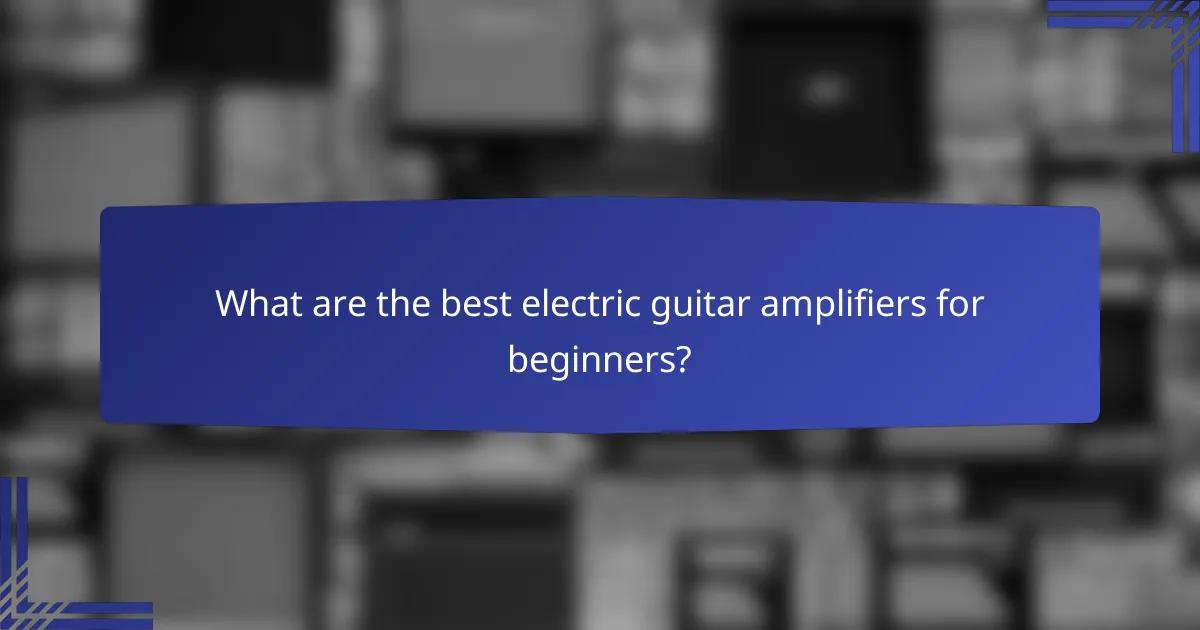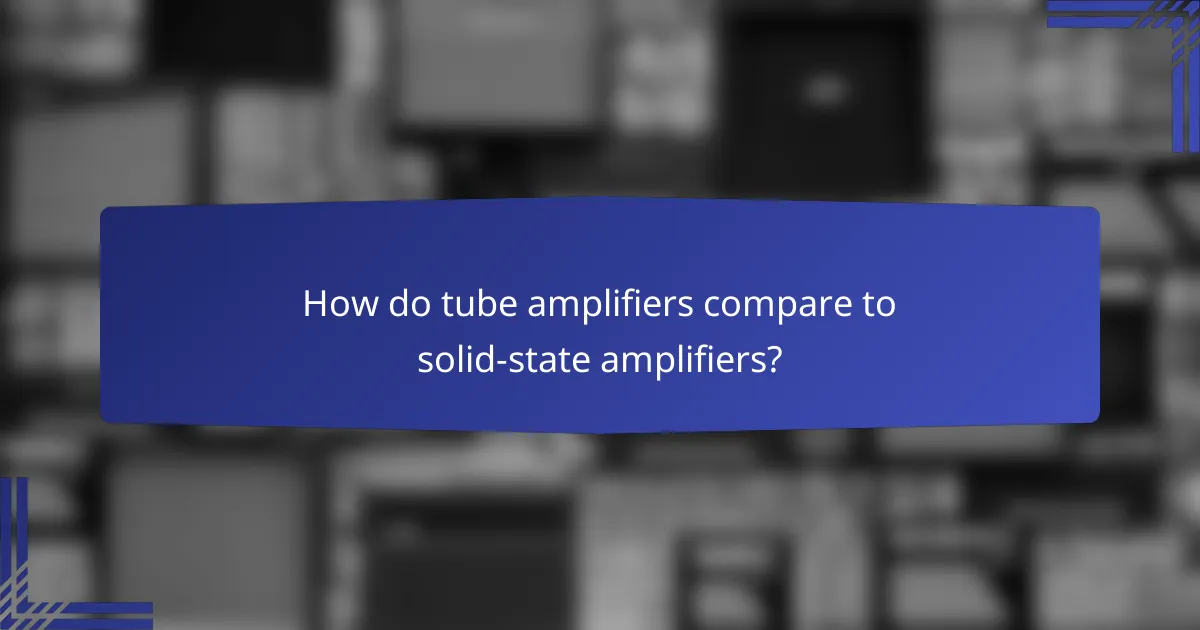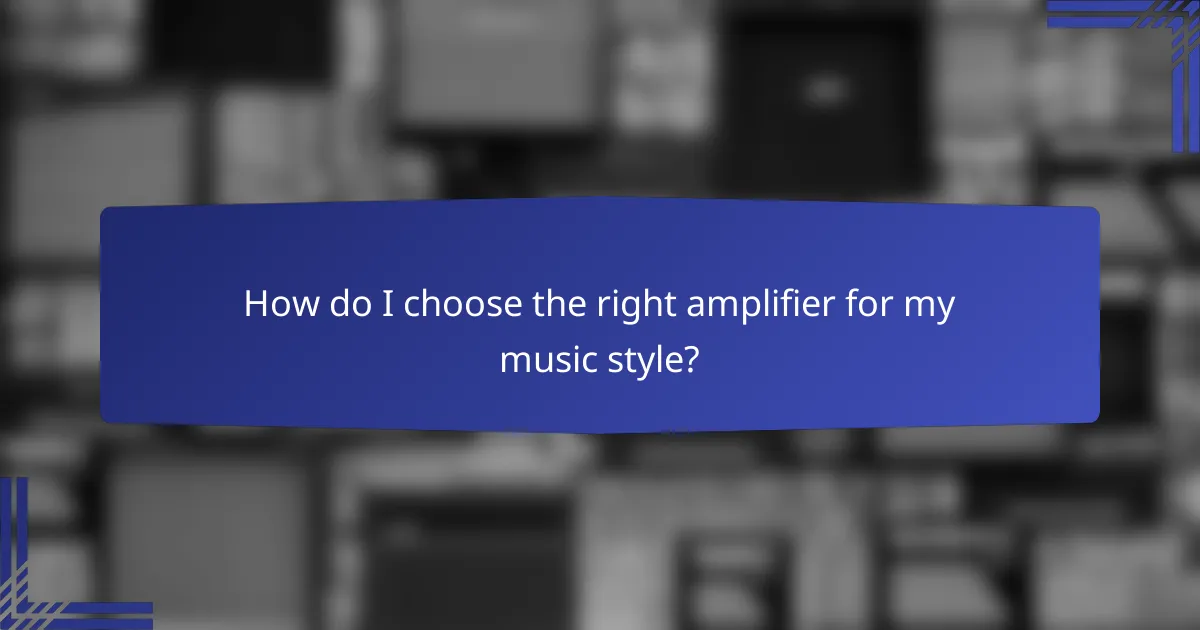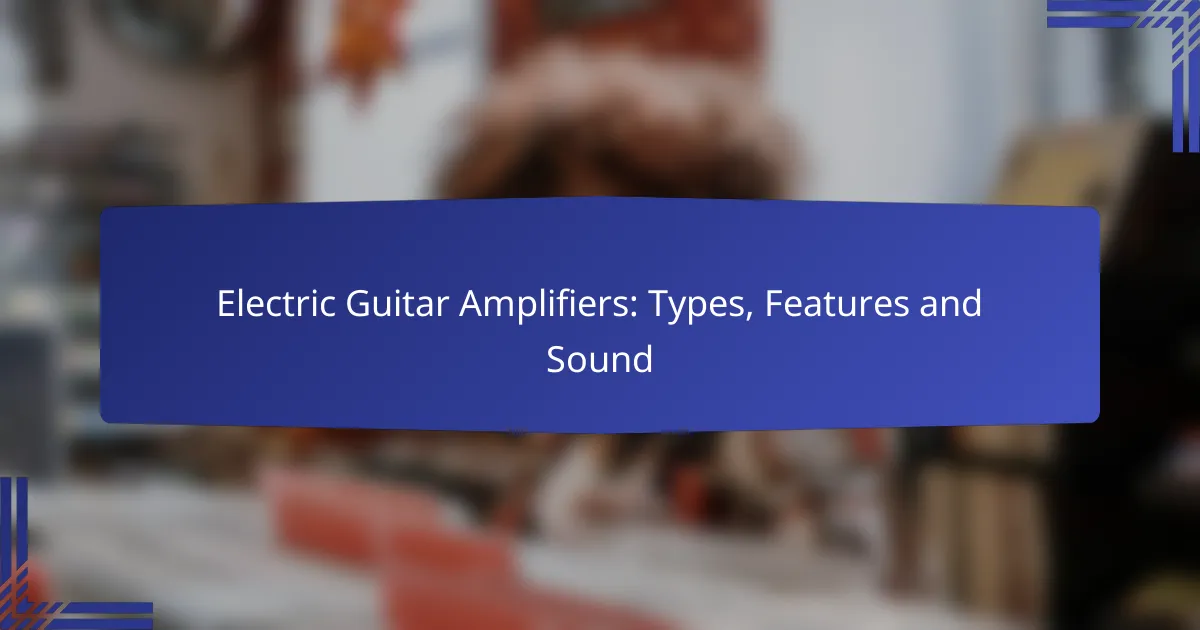Electric guitar amplifiers play a crucial role in shaping a guitarist’s sound, with various types available to suit different needs and preferences. From beginner-friendly models to advanced tube and solid-state options, each amplifier offers unique features that influence tone, portability, and versatility. Understanding these differences can help players select the right amp to enhance their musical experience.

What are the best electric guitar amplifiers for beginners?
The best electric guitar amplifiers for beginners are typically lightweight, user-friendly, and versatile, allowing new players to explore various sounds without overwhelming complexity. Models like the Fender Champion 20, Vox Pathfinder 10, and Roland Micro Cube are popular choices, each offering unique features that cater to novice musicians.
Fender Champion 20
The Fender Champion 20 is a compact and affordable amplifier that delivers a range of tones suitable for various music styles. With 20 watts of power and a single 8-inch speaker, it provides enough volume for practice sessions and small gigs.
This amp features multiple built-in effects, including reverb and delay, which can enhance your sound without needing additional pedals. Its intuitive controls make it easy for beginners to dial in their desired tone quickly.
Vox Pathfinder 10
The Vox Pathfinder 10 is another excellent option for beginners, known for its classic Vox sound and vintage design. With 10 watts of power and a 6.5-inch speaker, it is perfect for home practice and small settings.
It includes a clean and overdrive channel, allowing players to switch between a crisp tone and a more distorted sound easily. The Pathfinder 10’s simple layout and responsive controls make it user-friendly for those just starting out.
Roland Micro Cube
The Roland Micro Cube is a portable amplifier that packs a punch, making it ideal for beginners who need versatility on the go. With 2 watts of power and a 5-inch speaker, it is lightweight and easy to carry while still offering impressive sound quality.
This amp features a variety of built-in effects and amp models, enabling users to experiment with different sounds. Its battery operation capability allows for practice anywhere, making it a great choice for aspiring guitarists who travel frequently.

How do tube amplifiers compare to solid-state amplifiers?
Tube amplifiers and solid-state amplifiers differ significantly in sound, performance, and maintenance. Tube amps are known for their warm, rich tones, while solid-state amps offer reliability and consistency at a lower cost.
Tone quality differences
Tone quality is a major distinction between tube and solid-state amplifiers. Tube amplifiers produce a natural compression and harmonic distortion that many musicians find pleasing, often described as “warm” or “rich.” In contrast, solid-state amplifiers deliver a cleaner sound with less coloration, making them suitable for genres that require precision.
Musicians often choose tube amps for blues, rock, and jazz, where warmth and character are essential. Solid-state amps are frequently preferred in settings where durability and consistent performance are critical, such as in live sound or practice environments.
Maintenance requirements
Maintenance needs vary greatly between tube and solid-state amplifiers. Tube amplifiers require regular tube replacements and bias adjustments, which can be time-consuming and may necessitate professional servicing. Users should expect to replace tubes every few months to a couple of years, depending on usage.
On the other hand, solid-state amplifiers are generally low-maintenance, with no tubes to replace. They are built to withstand rough handling and environmental changes, making them ideal for gigging musicians who need reliability without frequent upkeep.
Cost considerations
Cost is another important factor when comparing tube and solid-state amplifiers. Tube amplifiers typically range from several hundred to several thousand dollars, reflecting their complex design and the cost of high-quality tubes. This investment often pays off in sound quality for serious musicians.
Solid-state amplifiers are usually more budget-friendly, often available for a few hundred dollars or less. This affordability makes them an attractive option for beginners or those who prioritize durability and versatility over tonal warmth.

What features should I look for in an electric guitar amplifier?
When selecting an electric guitar amplifier, consider wattage, effects options, and portability. These features significantly impact sound quality, versatility, and ease of transport, making them essential for both practice and performance.
Wattage and volume
The wattage of an amplifier determines its volume and headroom. For home practice, amplifiers in the range of 5 to 20 watts are often sufficient, while gigging musicians may prefer 30 watts or more to ensure they can compete with drums and other instruments.
Higher wattage amplifiers can produce cleaner tones at higher volumes, but they may also be heavier and more expensive. Consider your playing environment and whether you need a practice amp or one suitable for larger venues.
Effects and modeling options
Many modern amplifiers come with built-in effects and modeling options, allowing for a wide range of sounds without needing additional pedals. Look for features like reverb, delay, and distortion, which can enhance your playing experience.
Modeling amplifiers simulate the sound of various amp types and effects, providing versatility for different genres. If you’re looking for a specific sound, research models that excel in those areas, as some may offer superior emulation of classic amps.
Portability and weight
Portability is crucial if you plan to transport your amplifier frequently. Weighing under 30 pounds is ideal for easy transport, especially for musicians who perform regularly.
Consider the size and design of the amplifier as well. Combo amps, which combine the amp and speaker in one unit, are often more portable than separate head and cabinet setups. Evaluate your needs based on how often you will move the amp and the venues where you will play.

How do I choose the right amplifier for my music style?
To choose the right amplifier for your music style, consider the genre’s tonal characteristics and the amplifier’s features that best complement them. Each music style has specific requirements regarding sound quality, power, and effects, which can significantly influence your overall performance.
Amplifiers for rock music
Rock music typically benefits from amplifiers that deliver a strong, punchy sound with a good amount of distortion. Tube amplifiers are popular in this genre for their warm tones and dynamic response, often ranging from 30 to 100 watts for live performances. Look for models with built-in overdrive or distortion effects to enhance your sound.
Common choices include the Fender Hot Rod Deluxe and the Marshall JCM800, both known for their reliability and rock-friendly tones. When selecting an amplifier, consider your playing style and whether you prefer a clean sound that can be pushed into distortion or an amp that offers a more aggressive tone right out of the box.
Amplifiers for jazz music
Jazz music requires amplifiers that provide a clean, warm sound with a smooth response. Solid-state amplifiers are often favored for their reliability and clarity, typically operating between 20 to 50 watts for smaller venues. Look for features like reverb and EQ controls to tailor your sound to the nuances of jazz.
Popular models include the Roland Jazz Chorus and the Fender Blues Junior, both of which are known for their crisp sound and versatility. When choosing an amplifier, prioritize models that can reproduce the subtleties of your playing without coloring the tone excessively.
Amplifiers for metal music
Metal music demands amplifiers that can produce high gain and aggressive tones, often requiring models with power ratings from 50 to 120 watts. Tube amplifiers are favored for their rich harmonics, but many solid-state options also provide the necessary distortion and clarity. Look for amps with multiple channels to switch between clean and distorted sounds seamlessly.
Notable choices include the Mesa/Boogie Dual Rectifier and the Peavey 6505, both designed to handle the intense demands of metal music. When selecting an amplifier, consider the importance of features like built-in effects and the ability to handle heavy pedal use without losing sound quality.

What are the top brands of electric guitar amplifiers?
The top brands of electric guitar amplifiers include Marshall, Fender, and Orange, each known for their unique sound profiles and features. These brands cater to various playing styles and preferences, making them popular choices among guitarists worldwide.
Marshall
Marshall amplifiers are renowned for their powerful sound and distinctive crunch, making them a favorite among rock and metal guitarists. They offer a range of models, from small practice amps to large, stage-ready stacks, allowing players to choose based on their needs.
When selecting a Marshall amp, consider factors like wattage and speaker size, as these can significantly impact tone and volume. Popular models like the JCM800 and DSL series provide versatility and reliability, suitable for both live performances and studio recordings.
Fender
Fender amplifiers are celebrated for their clean tones and warm overdrive, making them ideal for genres like blues, country, and jazz. The iconic Fender Twin Reverb and Deluxe Reverb are particularly favored for their rich sound and dynamic response.
Fender amps often feature built-in reverb and tremolo effects, enhancing their versatility. When choosing a Fender amplifier, consider the amp’s power rating, as lower wattage models are great for home practice, while higher wattage options are better suited for live gigs.
Orange
Orange amplifiers are known for their bold, distinctive sound and vibrant aesthetics, appealing to guitarists who want a unique tone. Their designs often emphasize mid-range frequencies, making them popular for rock and alternative music.
Models like the Rockerverb and Tiny Terror offer a range of features, including tube-driven circuits and power scaling, which allows players to achieve high-gain sounds at lower volumes. When selecting an Orange amp, consider your tonal preferences and whether you need features like built-in effects or multiple channels.

What is the price range for electric guitar amplifiers?
The price range for electric guitar amplifiers varies significantly based on features, brand, and sound quality. Generally, you can find options from budget-friendly models under $200 to high-end amplifiers exceeding $800.
Budget options under $200
Budget amplifiers typically offer basic features suitable for beginners or casual players. These models often include simple controls and limited wattage, making them ideal for practice or home use.
Common brands in this category include Fender, Peavey, and Roland, with prices starting around $100. While they may lack advanced features, they can still deliver decent sound quality for the price.
Mid-range options $200-$800
Mid-range amplifiers provide a balance of quality and features, making them suitable for both practice and live performances. These models often include additional effects, better speaker quality, and more versatile sound options.
Brands like Marshall, Vox, and Line 6 offer a variety of choices in this price range, typically starting around $300. Players in this category can expect improved tone and durability, making them a worthwhile investment.
High-end options over $800
High-end electric guitar amplifiers are designed for professional musicians and serious hobbyists. These models often feature advanced technology, superior sound quality, and extensive customization options.
Brands such as Mesa/Boogie, Orange, and Hughes & Kettner dominate this market, with prices frequently exceeding $1,000. Investing in a high-end amplifier can significantly enhance your sound and performance capabilities, making it a valuable asset for any guitarist.
